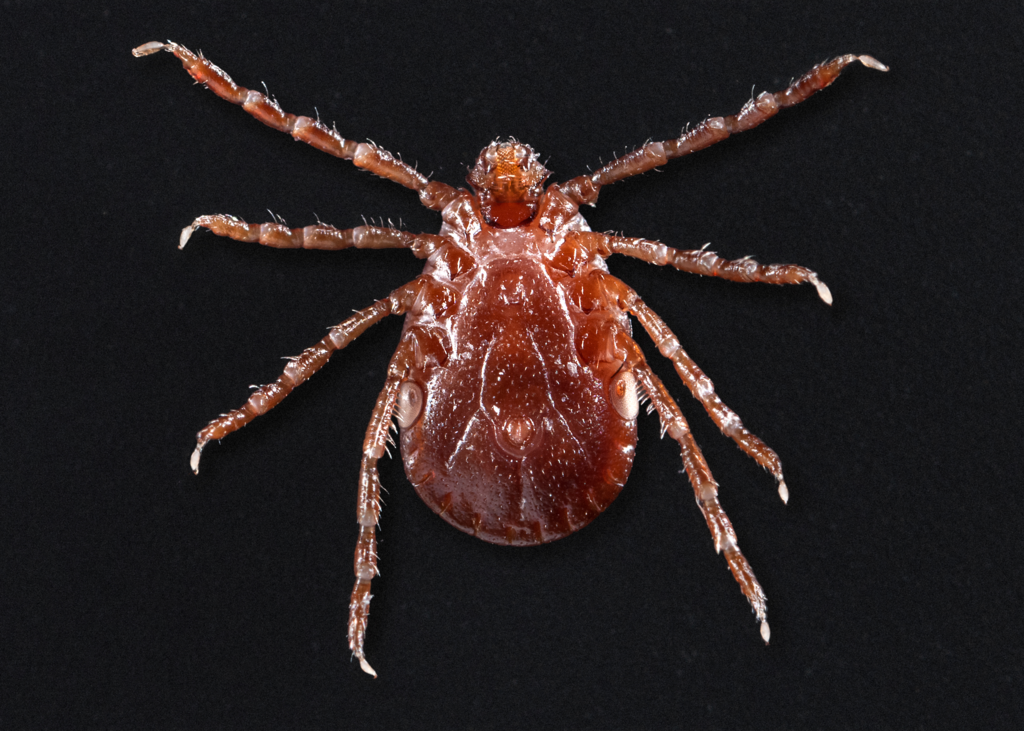Dangerous new tick species spreading
Years ago I read an author interview; she said something to the effect that writing ought to feel to an author as if they were water skiing behind their work, not towing it upstream like a barge. In general, I find this to be the case.

Asian longhorned tick (Haemaphysalis longicornis), enlarged from 2.3 mm. Photo: James Gathany, public domain
However, when I tried to water-ski behind a brand-new invasive tick that can reproduce without mating, drain the blood out of livestock, and potentially carry ten or more human diseases, including one similar to Ebola, something changed. This one made me drop the whole water-skiing idea and swim for my life.
The invasive species, Haemaphysalis longicornis, is commonly called the bush tick, Asian longhorned tick, or simply the longhorned tick, which is confusing since a number of invasive wood-boring beetles also bear the name “longhorn.” Native to parts of Central and East Asia, as well as to Fiji, New Zealand, Australia, Hawaii and other Pacific islands, it was first identified in North America in November 2017 in Hunterdon County, New Jersey. A lone pet Icelandic sheep had been critically weakened from blood loss due to the estimated thousand longhorned ticks which were found attached to it.
How the tick arrived in New Jersey remains a mystery, since the sheep had reportedly never been off the manicured, upscale property, but birds sometimes give ticks free air miles. Within a few months, authorities had confirmed it in several other states, and as of August 2018, it is believed to be in nine states total, including New York, where it has been found in Westchester County. While U.S. Customs officials had found the longhorned tick on quarantined animals as long ago as 1969, this is the first time it has been found in the wild in North America. Given how far it has already spread, experts believe it has been here several years, perhaps as far back as 2013.
It is fairly nondescript, being light to dark brown, and lacking any visible “longhorns,” which can only be seen under magnification. It is also tiny, roughly the same size as the blacklegged or deer tick, and only half as big as a dog or wood tick. It is more rounded in outline than the deer tick, though, and a bit more textured. A Texas A&M University fact sheet offers these helpful details: “H. longicornus has a 5:5 apical hypostomal dentition, and with palp article 3 each possessing an elevated dorso-median spur.” Actually, a web search is a better bet.
To be fair to the longhorned tick—which is more than it deserves—at this time, it is not yet known to carry human pathogens here on this continent. In its home range it does transmit several species of Borreliaspirochete bacteria known to cause Lyme disease, as well as Babesiosis, spotted-fever rickettsia, Erlichiosis, Anaplasmosis, Khasan virus, Powassan virus and at least two other types of tick-borne encephalitis. A relatively new illness with symptoms like those of Ebola, called “severe fever with thrombocytopenia syndrome” or SFTS, is also carried by the longhorned tick in its native area.
Another “good” point is that humans to not appear to be one of its primary hosts. In the wild it prefers rodents and other small mammals, in addition to deer, bear, canines and hares. In domestic herds it travels fast, and can overwhelm and kill young livestock, and those weakened by internal parasites or other stressors. Female ticks reproduce without mating, laying about 2,000 eggs each after a blood meal. All the ticks which hatch out are females as well, a reproductive strategy known as parthenogenesis. Apparently, longhorned ticks may even have more than one generation per year.

DEET-based repellants with at least 20-30% concentration can help protect against these and other ticks. Photo: KVDP, Creative Commons, some rights reserved
The public is advised to continue with precautions they already use against deer ticks, especially the use of DEET (20% or stronger) on exposed skin, and the use of permethrin-treated clothes and gear. Since all ticks are ferried by rodents throughout rural, urban and suburban landscapes alike, using tick tubes such as the Damminix brand can be effective in reducing tick populations significantly. Pets should be treated for ticks from April through December, and during unseasonably warm winters too. For help identifying ticks found on humans, contact your nearest Health Department or Extension office.
It is no fun writing about bad news, but in this case it is important we become aware of these newcomers. At least water skiing remains a tick-free activity.
Paul Hetzler is a horticulture and natural resources educator with Cornell Cooperative Extension of St. Lawrence County.






